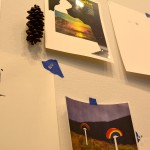illustration by Berke Yazicioglu
The Vikings — fierce, Scandinavian warriors and sailors, who came to America before Columbus — have fascinated the European and American public for centuries. Nordic sagas inspired Richard Wagner’s operas; the Vikings’ mythology was appropriated in Marvel’s comics and movies about Thor; the TV series Vikings, which airs on History Channel and claims to be historically accurate, has been gaining popularity and recently been renewed for a fourth season.
Vikings — currently on show at the Field Museum until October 4th — is a touring exhibition organized by the Swedish History Museum. The exhibition provides the audience with solid information about the Viking Era (8th-11th centuries in Scandinavia) and breaks stereotypes about ancient Scandinavian societies. For instance, that the Vikings wore helmets with horns is a misconception established in the 19th century. It also reveals that the Vikings were composed of diverse groups with different customs and religions and that they did not call themselves “Vikings”: the term was coined by historians. The Old Norse word Viking refers to “trade” or “raids.” When they were not sailing the seas, the Vikings led life as farmers or craftsmen. By exploring the relationship between contemporary cultural conceptions and archaeological data, the exhibition familiarizes its viewers with diverse aspects of Viking life, from food manners to shipbuilding. The comprehensive overview of the historical information displayed by the Field Museum can be seen in about an hour and is both compelling and easy to understand for visitors of all ages.
Even those who already know a lot about the topic will find nice surprises among the hundreds of amulets, weapons, jewelry, coins and crosses. For example, a Buddha figurine from India — found in Scandinavia — proves the large scale of the Vikings’ trade connections. A particularly interesting section of the exhibition explores how Scandinavian customs were affected by the encounter between Norse religion and Christianity. Pendants with imagery referring to both Christ and Odin suggest how two traditions intermingled for centuries. It is also explained how the Christianization of Scandinavia affected contemporary archaeological data — in places where cremation was replaced by Christian burial (inhumation), scientists were able to garner more information from biological remains.
In addition to traditional, informational display, Vikings includes some interactive attractions. Visitors can learn about Norse creation myths through 3-D graphic visualization, test their knowledge about the Vikings through a quiz, or weigh in their hands a replica of an iron sword. These features serve as a supplement to the educational aspect of the exhibition rather than an attraction by themselves. Therefore, some visitors (particularly children) who expect “fun” while looking at graphically appealing advertisements that are posted all around Chicago, might feel a bit disappointed. However, Vikings might be a relief after experiencing how other museums seem to focus on entertaining young visitors more than on educating the general audience.
Unfortunately, the exhibition suffers from a lack of space. It seems that the displays were designed to accommodate a fewer number of visitors than is currently allowed at once in the exhibition. The space gets crowded easily, which impedes the audience from fully enjoying their experience. For example, the visualization of Norse cosmology requires some time to explore — the mythological Universe is divided into several parts, with rich commentary about each of them. However, there is only one computer screen provided for that attraction, so visitors feel like they can interact with it for a very short time to make space for others. Having more equipment for interactive features would solve the problem of overflow, but the special exhibitions gallery lacks room for it. With hundreds of objects displayed, even the information about exhibits is sometimes located so awkwardly it is necessary to lean over to read it. The Field Museum could have predicted a large interest in the exhibition and made an effort to find a better location for it. If Vikings had opened after the closing of Vodou: Sacred Powers of Haiti (another special exhibition in the Field Museum) the exhibition could have occupied a space twice as large as the current one, giving visitors more room to learn and play. Vikings is definitely worth visiting — but with some patience, especially during the weekend.

















